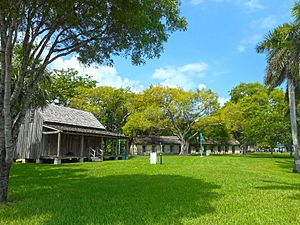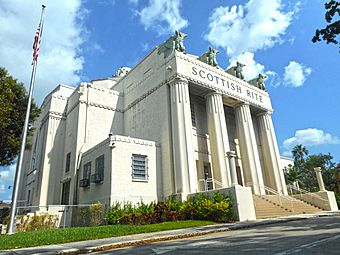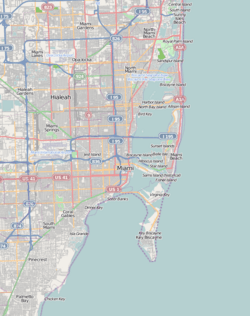Lummus Park Historic District facts for kids
Quick facts for kids
Lummus Park
|
|
|---|---|
|
Neighborhood of Miami
|
|

Wagner House and Fort Dallas barracks
|
|
| Nickname(s):
Lummus
|
|

Lummus Park neighborhood within the City of Miami
|
|
| Country | United States |
| State | Florida |
| County | Miami-Dade County |
| City | City of Miami |
| Incorporated | 1896 |
| Settled | 1909 |
| Population
(2010)
|
|
| • Total | 3,027 |
| • Density | 9,532/sq mi (3,680/km2) |
| Time zone | UTC-05 (EST) |
| ZIP Code |
33136
|
| Area code(s) | 305, 786 |
|
Lummus Park Historic District
|
|

Scottish Rite Temple, established in 1916, and built in 1924
|
|
| Location | Miami, Florida |
|---|---|
| NRHP reference No. | 06000952 |
| Added to NRHP | October 25, 2006 |
The Lummus Park Historic District is a special area in Miami, Florida. It is listed on the National Register of Historic Places in the United States. This means it is a place with important history. The district is generally located between Northwest Fifth Street (north), Flagler Street (south), Northwest Third Avenue (east), and the Miami River (west). It was added to the National Register on October 25, 2006. Lummus Park has some of Miami's oldest buildings. It still looks much like it did when pioneers first settled there.
Contents
Exploring Lummus Park's Past
Lummus Park was created in 1909. It was one of Miami's first open, green spaces for everyone to enjoy. The park's opening led to many buildings being built nearby. Most of the structures around the park were finished before 1926. The neighborhood shows off different building styles. These include Mediterranean Revival, Frame, and Masonry Vernacular designs. It is also home to Miami's old Scottish Rite Temple.
Lummus Park shows how Miami grew before the huge Florida land boom of the 1920s. The area around the park was planned out in 1909. This happened right after Lummus Park was created. The park helped the surrounding area become a neighborhood where people lived. The land for the neighborhood was first owned by the Model Land Company. This was Henry Flagler's real estate business. The buildings you see today, like the Scottish Rite Temple, show how Miami grew. Areas closest to the water and downtown developed early in the city's history.
This district is also important because it is one of the last neighborhoods close to downtown Miami. Over the years, the historic district became separated from the rest of downtown. This happened because of the I-95 highway being built to the east. Also, large tall buildings were constructed on nearby properties.
Historic Buildings in Lummus Park
Two buildings inside Lummus Park are very important. These are Fort Dallas and the William Wagner House. They are the last remaining structures from Miami's pioneer days. Both buildings were moved to the park to save them from being torn down. Moving Fort Dallas to Lummus Park was a mix of rebuilding and moving a structure. In the 1920s, people worked hard to save this building. This was Miami's first big effort to save historic places. It was a huge community project. The city was only about 30 years old when this preservation work began.
Architecture of Lummus Park
This neighborhood is also important because it shows the architecture from the early 1900s. The remaining Mediterranean Revival and Frame and Masonry Vernacular homes and buildings show styles that were common in downtown Miami. These styles were popular mainly in the 1910s and 1920s. The simple frame houses and early apartment buildings made of masonry show the types of homes that once filled Downtown Miami. Only the buildings in this historic district remain as a small part of that past. The park, its recreation buildings, the Trinity CME Church, and the Scottish Rite Temple help remind us how lively this neighborhood once was. They also mark the district's borders.
The buildings in Lummus Park show the different architectural styles used when Miami was first built. Besides the two pioneer-era structures, there are many examples of Frame Vernacular homes. These were built quickly and cheaply using local materials. These homes and apartment buildings were influenced by other local buildings. They were also designed for Miami's sub-tropical climate. The Mediterranean Revival style in the neighborhood shows a popular local style. It uses building ideas from countries with similar climates and close to water. The Scottish Rite Temple has unique architecture. This makes it a very important landmark in the city.
Special Designated Buildings
- Fort Dallas: This is the oldest example of building with local limestone in Miami. It is the only remaining structure from Miami's early military history.
- William Wagner House: This house was moved in 1979 to its current spot. It was the home of William Wagner, an important pioneer citizen. He was responsible for building the first church in Miami-Dade County. The house itself is a special example of "braced frame" construction in the area.
- Scottish Rite Temple
Getting Around Lummus Park
Lummus Park can be reached by Metrobus services throughout the area. You can also use the Miami Metrorail at:
- Government Center (NW 1st Street and NW 1st Avenue)
Gallery
See also
 In Spanish: Distrito histórico de Lummus Park para niños
In Spanish: Distrito histórico de Lummus Park para niños








